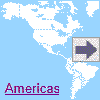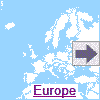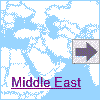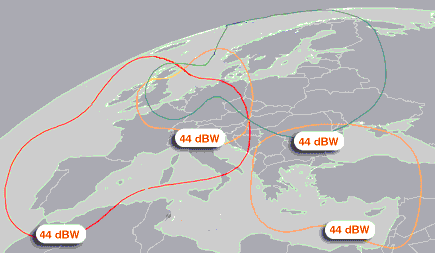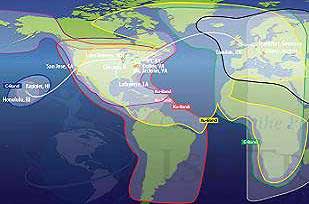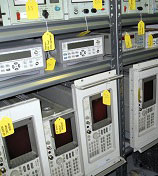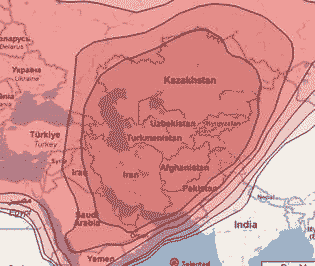Are you ready for digital?
Posted by
world Jr at Tuesday, January 27, 2009
Satellite Internet Service
(by Corey Klein - January 28, 2009)
Your guide to making the conversion carefree
If all of your televisions are connected to cable or satellite you will not be affected by the upcoming digital conversion, according to cable officials. Each television in a home wired to a cable or satellite service will continue receiving the same channels as it had prior to Feb. 17, or, if a bill to move the switch passes through congress, June 12.
"If you are already subscribed to cable television or satellite, you don’t have to do anything," said Charles Smith, the director of Government Affairs for Comcast in New Jersey.
Area residents arrived at the Queen of Peace Knights of Columbus Hall on River Road in North Arlington to ask Smith what the digital transition is all about. For televisions that receive their signal from an antenna or "rabbit ears," service will cease after the switch takes place without the purchase of an $80 digital converter box.
Switch does not affect cable/satellite subscribers
The switch only affects those who do not pay for television service and receive their signal for free from the airwaves. If you are one of the 14 million who use a rooftop antenna or "rabbit ears" or you don’t have digital television you must purchase a digital converter box and connect it to the analog television set. Otherwise, those televisions will not receive a signal after the switch. Converter boxes will be available for purchase at stores such Radio Shack and Walmart.
Televisions that receive television signals from the airwaves, as opposed to cable wires from the ground or a satellite dish, must have a digital converter box to continue receiving broadcast television. Aside from purchasing a digital converter box, which could cost up to $80, those who wish to keep free television coming into their homes from the airwaves could purchase a digital television, which automatically receives digital signals, according to Smith.
Televisions purchased more than a few years ago, however, are more than likely not digital. To find out if a television is digital-ready, one can look for a label or marking indicating they contain digital tuners. These labels may contain words such as "Integrated Digital Tuner," "Digital Tuner Built-In," "Digital Receiver," or "Digital Tuner," "DTV," "ATSC," or "HDTV" (High Definition television). "If your television equipment contains any of these labels or markings, you should be able to view digital over-the-air programming without the need for a digital-to-analog converter box," according to information provided by the federal government.
Televisions sold after March 1 must contain a label indicating whether or not they have a digital tuner.
Why are we switching to digital?
The federal government wants the broadcast and cable television industries to make the switch because there is a finite amount of bandwidth available and a digital signal takes up less "space", allowing more data to be transferred through cable wires and through the air. Data includes not only more television channels, but telephone and Internet lines as well.
In 2005, Congress authorized this transition, which will move broadcast television from an analog signal to a digital signal. "The federal government has decreed they will reclaim all of the analog bandwidth and mandating that television broadcasters as of Feb. 17 [or June 12], broadcast in a digital format only," said Smith.
America’s switch to digital follows other countries, such as Japan and many European countries, who have already made the switch. "We are moving to a digital world," said Smith.
Converter box coupons gone
In order to deflect the heavy cost of a converter box, the federal government instituted a coupon program, allowing Americans to apply for $40 coupons toward purchasing converters. Congress provided a fixed amount of money for the coupon program and it ran out, according to Smith. "They’re going to have to fund the money to get it to you as a consumer," he said.
One saving grace for those seeking to apply for coupons is that the coupons are only valid for 90 days and many who obtained coupons never used them, meaning the money goes back in the federal government’s pocket.
Could it be put off?
President Barack Obama and Congress are seeking to delay the Feb. 17 transition to June 12. A bill passed unanimously in the U.S. Senate on Jan. 26 and will soon go to a vote with the U.S. House of Representatives. But there is still a chance the Feb. 17 transition could continue as planned, according to Smith. "We in the cable industry and in the broadcast industry are going ahead as if this is going to happen on Feb. 17," he said.
Comcast is offering a promotion to new customers concurrent with the digital switch, allowing customers to receive free basic service for up to 12 months if one were to sign up for their telephone or Internet service. If a customer chooses, he or she can also receive basic service at $10 per month without the phone or Internet service.
Smith did not have figures on how many households in the south Bergen area use antennas or rabbit ears to receive television. "In this area, generally speaking, the Comcast service area, we have a pretty high penetration in the area that we live," he said. "But those numbers are not insignificant."
In the room of 13 people, there were no households without at least one television with digital service, but there were a number of households with several television sets, some hooked up to cable and some running off of antennas. "Not every television in someone’s home is connected to cable or satellite," said Smith.
One man in attendance said the digital switch would affect some of his television sets and not others. "I have seven TVs, half-digital and half-analog," he said.
"All-digital" cable
The government’s decision to switch broadcast television from an analog signal to a digital signal is separate from what is called "all-digital cable." Comcast’s competitor in the area, Verizon, has already switched to an entirely digital system. Smith said a date has not been set for Comcast’s switch, but it is unrelated to the 2009 Digital Conversion being ordered by the federal government. It is simply a Comcast issue.
Television in homes subscribed to a digital cable network like Verizon require a cable box. Currently, Comcast subscribers with basic cable television can still receive their cable without a box. According to Smith, this is set to change in the future when they go digital.
"We’ve already done it in New Jersey in our northwest systems, so that transition is imminent. It’s going to happen. You will need a [cable] box," said Smith.
source: www.southbergenite.com













